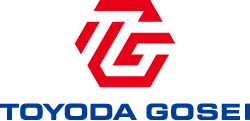Functional Components
- HOME
- Functional Components
These rubber and plastic components support the basic vehicle functions of driving, turning and stopping. Toyoda Gosei technology ensures quality for these key safety-related parts.
Fuel Components

1Plastic fuel filler pipes
Single-piece molding of sections with different characteristics (flexible, rigid, and straight sections) assures the strength of these pipes, while their multi-layer structure improves fuel resistance and durability. These technologies have made it possible to reduce weight by nearly 50% compared with previous metal pipes.

2Fuel filler caps
These caps are attached to prevent fuel leakage from the intake port when the gas pump nozzle is inserted, by functioning as a seal.

3Capless fuel fillers
A device designed to make refueling more convenient by simply inserting the nozzle without opening or closing the filler cap when refueling.

4Fuel hoses and tubes
These rubber and plastic pipes send fuel to the engine and fuel vapor to the atmosphere via the fuel vapor cleaner.

5Cutoff valves
These valves prevent the elevation of pressure inside the tank by releasing vaporized gasoline when the internal temperature rises. The number used on a vehicle has been reduced by raising the ventilation performance with a modified structure, contributing to lighter weight of the fuel tank overall.

6Fill limit vent valves
These valves restrict the amount of fuel when the tank becomes full, functioning to seal and prevent variation in fuel levels.

7Inlet check valve
Check valves prevent fuel from flowing backwards out of the fill tube opening when the tank becomes full.

8High pressure hydrogen tanks
One of the main components of fuel cell electric vehicles (FCEVs). Hydrogen is efficiently stored with a high pressure of about 700 atm.

9Large high-pressure hydrogen tanks
These tanks are used mainly on commercial vehicles and boats. They can hold about eight times as much hydrogen as the tanks for passenger vehicles (left).

10Portable hydrogen cartridges
Hydrogen can be carried safely and easily, and mounted in various devices such as hydrogen cooking equipment, fuel cells. This widens the applications of hydrogen energy.

Battery Components

11Cooling pipes
Maintaining batteries at the proper temperature leads to longer battery life, while also contributing to increased driving range.

12Battery cases
Battery case made of plastic stores multiple batteries.

Engine Components

13Plastic turbo ducts
These pipes send compressed air to raise engine output. In addition to withstanding high pressure and temperature, they absorb engine vibrations. (Long, complex pipes are blow formed with plastic, reducing weight by about 50%.)

14Radiator hoses
These hoses connect the engine and radiator for the circulation of the coolant that is needed to cool the engine.

15Noise absorbing air intake ducts
These ducts take in outside air needed in engine revolution. Intake noise is reduced with the use of air permeable members in part of the duct.

16Air cleaner hoses with resonator
Air cleaner hoses are used in providing the clean air needed for engine revolution. Resonators reduce the noise that is generated when air is taken in.

17Engine covers
By covering the top of the engine, these covers make the engine compartment more aesthetically pleasing and reduce noise from the engine itself.

18Plastic water pipes
These pipes are placed around the engine. They include several types with different functions. They are used for air conditioning, oil cooling, turbo cooling, and other functions.

Chassis and Drive Train Components

19Brake hoses
These are crucial parts in vehicle braking, and must pass a durability test of more than 5 million repetitions.

20Constant velocity joint boots
These boots have a cylindrical, bellows shape and are used to cover constant velocity joints, which turn and flex. They keep joint lubricating grease in and water and dirt out.

21Oil pumps
These pumps suction up and circulate oil to reduce friction in the transmission gears and bearings. Leveraging our plastic precision molding technology, we have made the gears and other oil pump components of plastic and reduced mass by about 30%.

